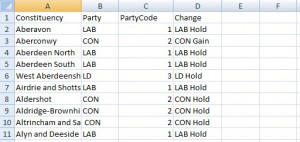We released a new feature on the MapTube website today which will make it easier to create new maps from data in CSV files. The underlying technology is used on the SurveyMapper site and for other real-time visualisations like http://bigdatatoolkit.org/2011/07/26/1yeartogo/ which shows tweets using the #1yeartogo hashtag for the London 2012 Olympics.

The new update to MapTube adds a graphical user interface which allows the user to upload a data file, choose a colour scale and publish the map on MapTube directly. One of the driving forces behind this was the idea that creating a map should be simple enough that you could do it using an iPad. Data on the London Datastore is in the correct format, so you can copy the CSV link directly from the site, which is exactly what has been done in the above image. I’ve created a YouTube clip showing the whole process, which can be viewed at the following link:
http://www.youtube.com/watch?v=naaSv7ihGOQ
This feature is still experimental, but at the m0ment it handles point data in lat/lon coordinates (WGS84) or OS coordinates for the UK (OSGB36). Point data can be drawn using markers, or as a heatmap showing point density. For area data, one column in the data is selected as a key field and this is joined with the geographic data stored in MapTube’s database to draw the map. For example, using the following data:
We have four columns: Constituency, Party, PartyCode and Change. In the CSV file the first line must be the column headings, then every subsequent line contains data. The CSV file would contain the following:
Constituency,Party,PartyCode,Change Aberavon,LAB,1,LAB Hold Aberconwy,CON,2,CON Gain etc...
The “Constituency” column is the area key in this case, but MapTube determines this automatically when the CSV file is loaded, along with the type of geography, which is Parliamentary Constituencies. In order to colour the map, numeric data is required, so in this example, a column labelled “PartyCode” has been added where “LAB”=1, “”CON”=2, LD=”3” etc.
The colour scale is then chosen and the finished map submitted to MapTube where it can be viewed along with any of the other maps. There are help pages accessible through the ‘i’ icon on each section which contain further information.
As mentioned before, this feature is still experimental and we will be gradually adding more geographic data to the MapTube database to allow maps to be built from additional geographies. The aim is for MapTube to be able to automatically detect the geography just by analysing the data and, at the moment, the following geographies can be used:
Government Office Regions (UK) (GOR) Lower level super output areas (UK) (LSOA) Medium level super output areas (UK) (MSOA) Output Areas (UK) (OA) Postcode Districts (UK) (PostcodeDistricts) County and Unitary Authority (UK) (CountyUA and ONSCountyUA) Districts (UK) (Districts and ONSDistricts) Census Area Wards (UK) (CASWards) World Borders 2010 (WorldBorders2010ISO2 and ISO3 using the ISO country codes) Parliamentary Constituencies 2010 (UK) (PCON2010)
US States and Zip code areas will be added shortly, along with adminsitrative and Census boundaries for other parts of the World.

